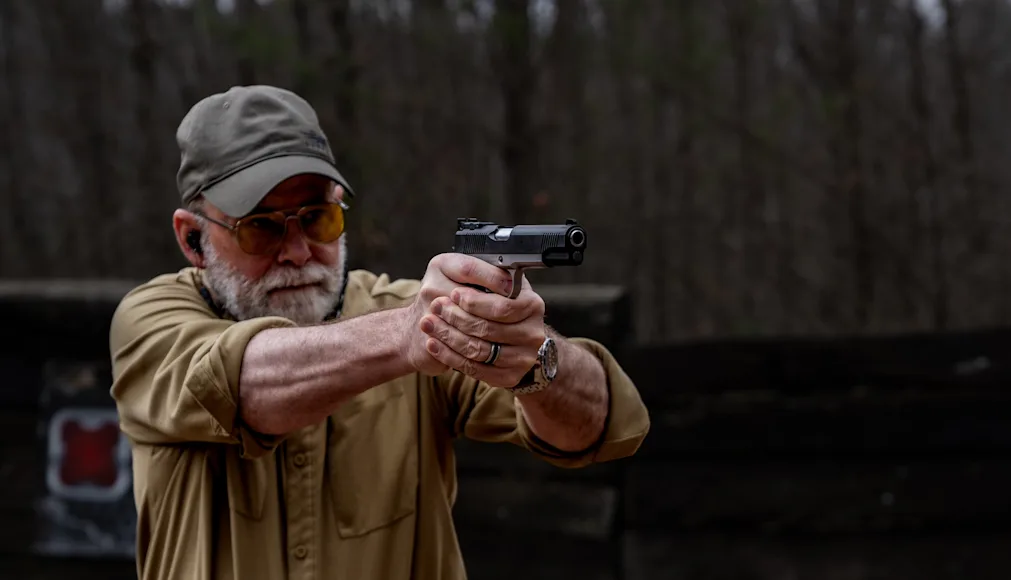_We may earn revenue from the products available on this page and participate in affiliate programs. Learn more ›
_
Back in muzzleloading days, guns designed to be held and fired with one hand were called pistols. With the advent of the revolver—a repeating handgun with a revolving cylinder—this didn’t really change. Many still referred to a revolver as a pistol. Toward the end of the 19th Century, another handheld firearm was invented, and it was neither a muzzleloader nor revolving pistol—it was a semi-automatic. Just like the handguns before it, everyone called it a pistol too. In fact, up until dictionaries and the BATF (Bureau of Alcohol Tobacco and Firearms) got involved, all handguns were generally considered pistols, and the debate of pistols vs handguns really didn’t exist. If a man said he was going to get his pistol, you knew he was going to get a gun he could shoot with one hand. But then things got confusing.

When a revolver is loaded, the ammunition is put into a chamber in the cylinder as opposed to the barrel as it would be with a pistol. Richard Mann
Pistol vs Handgun: Table of Contents
The Definition of Pistol vs Handgun
What About Derringers?
Pistol vs Handgun Ammunition
The Bottom Line
advertisement
The Definition of Pistol vs Handgun
The accepted dictionary definition of a pistol states it’s a handgun with a chamber that is integral to the barrel. Well, what does that mean exactly? The chamber of a firearm is the place where the cartridge is inserted to be fired. With a semi-automatic handgun, the chamber is part of the barrel—just like on a rifle or shotgun. With a revolver, the chamber/s are in the cylinder. This means—according to those who write definitions—that a pistol is a handgun, but a revolver is not a pistol. So, if you get into a gunfight and pull out your revolver, technically you won’t be using a pistol to shoot it out with the bad guy.

On a pistol, the chamber and barrel are integral. Richard Mann
This all seems a bit ridiculous and a little confusing. All pistols are handguns, and a revolver can be a handgun, but a revolver cannot be a pistol. Of course, there are other types of handguns
that are not revolvers or semi-automatics, and they confuse the issue even further because they too are pistols. There are single-shot, break-action handguns like the Thompson Center Contender. A single-shot handgun is a long way from a semi-automatic handgun like a Glock, but just like the Glock, the Contender is a pistol too. The same would apply to a bolt-action pistol like the Remington XP 100. Like the Contender, the XP 100’s chamber is integral to the barrel, so, it’s a pistol…and a handgun.
What About Derringers?
But what about a two-barreled derringer? Is it a pistol or a handgun? A derringer is commonly defined as a short-barreled handgun that can be carried in a pocket. That sounds a lot like a compact revolver like Ruger’s LCR, but of course, a derringer does not have a cylinder and its chambers are integral to its barrels, so, just like a Glock, an itty bitty two-barreled derringer is a pistol. Considering a derringer as the same type of handgun as a Glock bothers me a bit. The two could hardly be more different. I think a derringer should just be called a derringer, even if it has two barrels with integral chambers.

This is a two-barrel derringer. Though it bears little resemblance to a semi-automatic Glock, it’s a pistol too. Richard Mann
advertisement
Pistol vs Handgun Ammunition
Here’s the other strange thing about handguns, pistols, and revolvers. Revolvers are typically chambered for cartridges designed to be fired in revolvers. But that’s not always the case. Some revolvers will chamber and fire pistol cartridges. Smith & Wesson makes a revolver that fires a 10mm pistol cartridge and Taurus makes a revolver that shoots shotgun shells, but neither are pistols. Pistols tend to shoot pistol cartridges, but that’s not always the case either. The Magnum Research Desert Eagle is a pistol that can shoot the 44 Magnum revolver cartridge. But here’s where it gets even weirder. The Thompson Center Contender is most often chambered for rifle cartridges, but it’s still a pistol.
The Bottom Line
All of this is confusing, so, let’s see if we can make some scientific sense out of it, or at least get it as clear as mud. Both revolvers and pistols are handguns. But only revolvers are revolvers and semi-automatics, single shots, bolt-action handguns, and derringers, are pistols. And the cartridges that these handguns fire have nothing to do with whether they are a revolver or a pistol.
.embed-container { position: relative; padding-bottom: 56.25%; height: 0; overflow: hidden; max-width: 100%; } .embed-container iframe, .embed-container object, .embed-container embed { position: absolute; top: 0; left: 0; width: 100%; height: 100%; }
See https://www.youtube.com/embed/lvmSxfMGldQon YouTube
Maybe we’d be better off taking a lesson from Clint Eastwood. There’s a scene in the movie, The “Outlaw Josey Wales
,” where his character is staring down four Union soldiers. He spits, gives the soldiers a malicious squint, and says, “Well you gonna pull those pistols or whistle Dixie?” The Union soldiers were armed with Colt revolvers, not pistols_,_ and while it might have sounded OK if the notorious Josey Wales would have referred to the soldier’s guns as “Colt’s,” if he would have said “handguns” or “revolvers” I just don’t think it would have had the same ring to it. So, as far as I’m concerned, if Clint Eastwood can call revolvers, “pistols,” that’s good enough for me.






